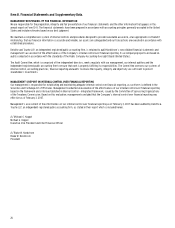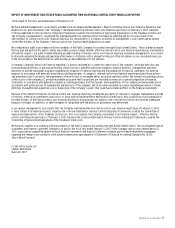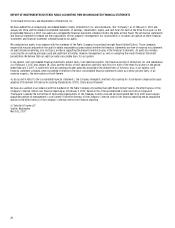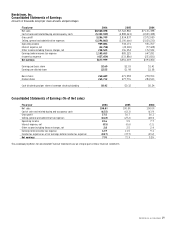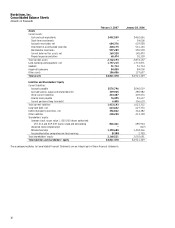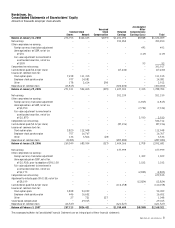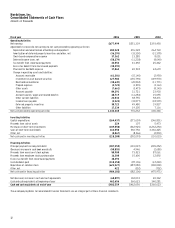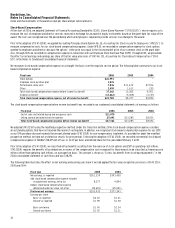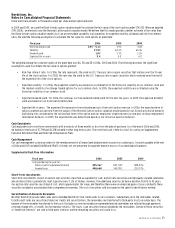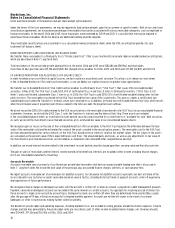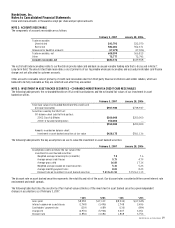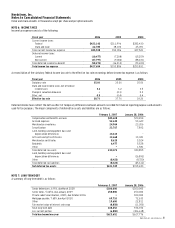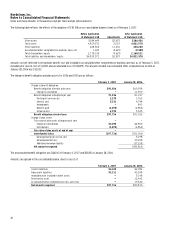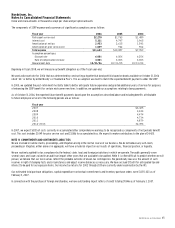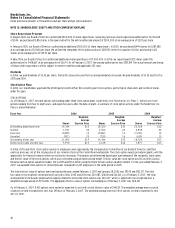Nordstrom 2006 Annual Report Download - page 54
Download and view the complete annual report
Please find page 54 of the 2006 Nordstrom annual report below. You can navigate through the pages in the report by either clicking on the pages listed below, or by using the keyword search tool below to find specific information within the annual report.36
Nordstrom, Inc.
Notes to Consolidated Financial Statements
Dollar and share amounts in thousands except per share and per option amounts
Under the terms of the trust agreements, we may be required to fund certain amounts upon the occurrence of specific events. Both of our credit card
securitization agreements set a maximum percentage of receivables that can be associated with various receivable categories, such as employee or
foreign receivables. At the end of 2006 and 2005, these maximums were exceeded by $1,509 and $1,211. It is possible that we may be required to
repurchase these receivables. We do not believe any additional funding would be required.
The private label securitizations are accounted for as a secured borrowing (on-balance sheet) while the VISA securitization qualifies for sale
treatment (off-balance sheet).
NORDSTROM PRIVATE LABEL RECEIVABLES (ON-BALANCE SHEET)
We transfer these receivables to a third-party trust (“Private Label Trust”) that issues two Nordstrom private label receivable backed securitizations,
which are described in Note 7: Long-term Debt.
Total receivables of the securitized private label portfolio at the end of 2006 and 2005 were $582,281 and $549,962, and receivables
more than 30 days past due were $15,756 and $11,265. Net charged-off receivables for 2006, 2005, and 2004 were $17,183, $22,845, and $25,370.
CO-BRANDED NORDSTROM VISA RECEIVABLES (OFF-BALANCE SHEET)
In order to enhance our cost-effective capital sources, we have in place a securitized asset structure. This allows us to reduce our investment
in the co-branded Nordstrom VISA credit card receivables, so we can deploy our capital resources to greater-value opportunities.
We transfer our co-branded Nordstrom VISA credit card receivables to a third-party trust (“VISA Trust”) that issues VISA receivable backed
securities. In May 2002, the VISA Trust issued $200,000 of certificated Class A and Class B notes to third-party investors (“2002 Class A & B
Notes”) and a certificated, subordinate Class C note to us. In 2006, the VISA Trust issued $350,000 of certificated variable funding notes to third-
party investors. The receivables transferred to the VISA Trust exceed the face value of the issued notes. This excess creates a certificated, non-
subordinated asset called the Transferor’s Interest, which was conveyed to us. In addition, we hold a non-certificated Interest Only Strip, which results
when the estimated value of projected cash inflows related to the notes exceeds the projected cash outflows.
We do not record the $550,000 in debt related to the VISA securitization or the receivables transferred to the VISA Trust on our consolidated financial
statements. However, we do hold the 2002 Class C note, the Transferor’s Interest and the Interest Only Strip. These assets are included
in the consolidated balance sheets as investment in asset backed securities and accounted for as investments in “available-for-sale” debt securities.
As such, we record the investment in asset backed securities at its estimated fair value in our consolidated balance sheets.
We recognize gains or losses on the sale of the co-branded Nordstrom VISA receivables to the VISA Trust based on the difference between the face
value of the receivables sold and the estimated fair value of the assets created in the securitization process. The receivables sold to the VISA Trust
are then allocated between the various interests in the VISA Trust based on those interests’ relative fair market values. The fair values of the assets
are calculated as the present value of their expected future cash flows. The unrealized gains and losses, as well as any adjustments to fair value of
the investment in asset backed securities, are recorded as a component of accumulated other comprehensive earnings.
In addition, we record interest income related to the investment in asset backed securities based upon their carrying value and their discount rate.
The gain on sales of receivables and the interest income earned on the beneficial interests are included in other income including finance charges,
net in our consolidated statements of earnings.
Accounts Receivable
Accounts receivable consist primarily of our Nordstrom private label receivables that back an unused variable funding note that is discussed in
Note 7: Long-term Debt. We record the face value of the principal, plus any earned finance charges, late fees, or cash advance fees.
We report accounts receivable net of an allowance for doubtful accounts. Our allowance for doubtful accounts represents our best estimate of the
losses inherent in our customer accounts receivable based on several factors, including historical trends of aging of accounts, write-off experience
and expectations of future performance.
We recognize finance charges on delinquent accounts until the account is written off or when an account is placed into a debt management program.
Payments received on delinquent accounts are recorded in the same manner as current accounts. Our approach for resuming accrual of interest on
these accounts is made on an account by account basis. Delinquent accounts are written off when they are determined to be uncollectible, usually
after the passage of 151 days without receiving a full scheduled monthly payment. Accounts are written off sooner in the event of customer
bankruptcy or other circumstances making further collection unlikely.
The Nordstrom private label card operating expenses, including bad debt costs, are included in selling, general, and administrative expenses. Finance
charges and late fees generated by the private label cards are classified as part of other income including finance charges, net. Revenue amounts
were $104,415, $97,036 and $102,406 in 2006, 2005, and 2004.


